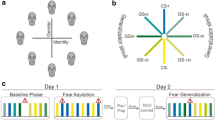Abstract
TwoCebus albifrons monkeys were given discriminative operant conditioning with visual stimuli, with Sidman avoidance and punishment as the components. The instrumental response was an unelicited increase in skin conductance. Both animals had surgically implanted catheters for automatic injection of morphine into the heart. After autonomic conditioning, the animals were given the opportunity to self-administer the morphine by touching the primate press panel that displayed the visual stimuli. One contingency-free segment per session was used for morphine injection, while the contingencies remained in force during the other segments. One of the monkeys made significantly more skin conductance responses during avoidance than during punishment, and this monkey received ten times as many shocks in punishment. This monkey also made more responses overall and had a much higher heart rate than the other animal. The other monkey did not differentiate significantly autonomically and received equal numbers of shocks in avoidance and punishment. The monkey that showed autonomic differentiation made significantly (and increasingly) more panel-presses during punishment than during avoidance. The other animal showed hardly any tendency at all to panel-press.
Similar content being viewed by others
References
Birbaumer, N., and Kimmel, H. D.:Biofeedback and Self-Regulation. New Jersey: Lawrence Erlbaum Associates, 1979.
Brown, J. S.:Motivation of Behavior. New York: McGraw-Hill, 1961.
Dollard, J., and Miller, N. E.:Personality and Psychotherapy. New York: McGraw-Hill, 1950.
Eysenck, H. J.: The conditioning model of neurosis.The Behavioral and Brain Sciences, 2:155–199, 1979.
Freud, S.:The Problem of Anxiety. New York: Norton, 1936.
Kimmel, H. D.: Management of conditioned fear.Psychological Reports, 12:313–314, 1963.
Kimmel, H. D.: Inhibition of the unconditioned response in classical conditioning.Psychological Review, 73:232–240, 1966.
Kimmel, H. D.: Instrumental conditioning of autonomically mediated behavior.Psychological Bulletin, 67:337–345, 1967.
Kimmel, H. D.: Instrumental conditioning of autonomically mediated responses in human beings.American Psychologist, 29:325–335, 1974.
Kimmel, H. D.: Conditioned fear and anxiety. In C. D. Spielberger and I. G. Sarason (Eds.):Stress and Anxiety. Vol. 1. Washington, D. C.: Hemispheric Publishing Co., 1975.
Kimmel, H. D., Brennan, F., McLeod, D., Raich, M., and Schonfeld, I.: Instrumental electrodermal conditioning in the monkey(Cebus albifrons): Acquisition and longterm retention.Animal Learning and Behavior, 7:447–451, 1979.
Kimmel, H. D., and Burns, R. A.: Adaptational aspects of conditioning. In W. K. Estes (Ed.):Handbook of Learning and Cognitive Processes. Vol. 2. Hillsdale, N. J.: Lawrence Erlbaum Associates, 1975.
Kimmel, H. D., and Burms, R. A.: The difference between conditioned tonic anxiety and conditioned phasic fear: Implications for behavior therapy. In I. G. Sarason and C. D. Spielberger (Eds.):Stress and Anxiety. Vol. 4. Washington, D. C.: Hemispheric Publishing Co., 1976.
Kimmel, H. D., and Burns, R. A.: Intereffector influences in operant autonomic control. In J. Beatty and H. Legewie (Eds.):Biofeedback and Behavior. New York: Plenum, 1977.
Lader, M. N.: Plantar skin conductance measures in anxiety and phobic states.Journal of Psychosomatic Research, 11:271–281, 1967.
Lader, M. H., and Wing, L.: Habituation of the psychogalvanic reflex in patients with anxiety states and in normal subjects.Journal of Neurology, Neurosurgery and Psychiatry, 27:210–218, 1964.
Lynch, J. J., Fertizinger, A. P., Teitelbaum, H. A., Cullen, J. W., and Gantt, W. H.: Pavlovian conditioning of drug reactions: some implications for drug addiction.Conditional Reflex, 8:211–223, 1973.
Miller, N. E.: Studies of fear as a learnable drive: I. Fear as motivation and fear reduction as reinforcement in the learning of new responses.Journal of Experimental Psychology, 38:89–101, 1948.
Miller, N. E.: Leamable drives and rewards. In S. S. Stevens (Ed.):Handbook of Experimental Psychology. New York: Wiley, 1951.
Mowrer, O. H.: A stimulus-response analysis of anxiety and its role as a reinforcing agent.Psychological Review, 46:553–565, 1939.
Mowrer, O. H.: Anxiety-reduction and learning.Journal of Experimental Psychology, 27:497–516, 1940.
Nichols, J. R.: How opiates change behavior.Scientific American, 212:80–88, 1965.
Schuster, C. R.: Behavioral analysis of opiate dependence. In S. Fisher and A. Freedman (Eds.):Opiate Addiction: Origins and Treatment. New York: Wiley, 1975.
Skinner, B. R.: “Superstition” in the pigeon.Journal of Experimental Psychology, 38:168–172, 1948.
Tyrer, P. J., and Lader, M. H.: Central and peripheral correlates of anxiety: A comparative study.The Journal of Nervous and Mental Disease, 162:99–104, 1976.
Author information
Authors and Affiliations
Additional information
This work was done with support from the U.S. Army Medical Research and Development Command, Grant number DAMD-17-76-C 6053, and is based on the second author’s M.A. thesis done under the direction of the first author.
Rights and permissions
About this article
Cite this article
Kimmel, H.D., Budrionis, M.M. Conditional fear, anxiety, and morphine-seeking behavior. Pav. J. Biol. Sci. 16, 163–172 (1981). https://doi.org/10.1007/BF03003223
Issue Date:
DOI: https://doi.org/10.1007/BF03003223



